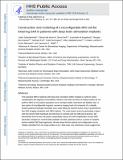| dc.contributor.author | Golestanirad, Laleh | |
| dc.contributor.author | Iacono, Maria Ida | |
| dc.contributor.author | Keil, Boris | |
| dc.contributor.author | Angelone, Leonardo M. | |
| dc.contributor.author | Bonmassar, Giorgio | |
| dc.contributor.author | Fox, Michael D. | |
| dc.contributor.author | Herrington, Todd | |
| dc.contributor.author | Adalsteinsson, Elfar | |
| dc.contributor.author | LaPierre, Cristen | |
| dc.contributor.author | Mareyam, Azma | |
| dc.contributor.author | Wald, Lawrence L. | |
| dc.date.accessioned | 2020-12-08T23:25:05Z | |
| dc.date.available | 2020-12-08T23:25:05Z | |
| dc.date.issued | 2017-02 | |
| dc.date.submitted | 2016-05 | |
| dc.identifier.issn | 1053-8119 | |
| dc.identifier.uri | https://hdl.handle.net/1721.1/128750 | |
| dc.description.abstract | Post-operative MRI of patients with deep brain simulation (DBS) implants is useful to assess complications and diagnose comorbidities, however more than one third of medical centers do not perform MRIs on this patient population due to stringent safety restrictions and liability risks. A new system of reconfigurable magnetic resonance imaging head coil composed of a rotatable linearly-polarized birdcage transmitter and a close-fitting 32-channel receive array is presented for low-SAR imaging of patients with DBS implants. The novel system works by generating a region with low electric field magnitude and steering it to coincide with the DBS lead trajectory. We demonstrate that the new coil system substantially reduces the SAR amplification around DBS electrodes compared to commercially available circularly polarized coils in a cohort of 9 patient-derived realistic DBS lead trajectories. We also show that the optimal coil configuration can be reliably identified from the image artifact on B 1+ field maps. Our preliminary results suggest that such a system may provide a viable solution for high-resolution imaging of DBS patients in the future. More data is needed to quantify safety limits and recommend imaging protocols before the novel coil system can be used on patients with DBS implants. | en_US |
| dc.description.sponsorship | NIH (Grants K99EB021320, R01EB006847, and P41EB015896) | en_US |
| dc.language.iso | en | |
| dc.publisher | Elsevier BV | en_US |
| dc.relation.isversionof | http://dx.doi.org/10.1016/j.neuroimage.2016.12.056 | en_US |
| dc.rights | Creative Commons Attribution-NonCommercial-NoDerivs License | en_US |
| dc.rights.uri | http://creativecommons.org/licenses/by-nc-nd/4.0/ | en_US |
| dc.source | PMC | en_US |
| dc.title | Construction and modeling of a reconfigurable MRI coil for lowering SAR in patients with deep brain stimulation implants | en_US |
| dc.type | Article | en_US |
| dc.identifier.citation | Golestanirad, Laleh et al. "Construction and modeling of a reconfigurable MRI coil for lowering SAR in patients with deep brain stimulation implants." NeuroImage 147 (February 2017): 577-588 © 2016 Elsevier Inc | en_US |
| dc.contributor.department | Massachusetts Institute of Technology. Department of Electrical Engineering and Computer Science | en_US |
| dc.relation.journal | NeuroImage | en_US |
| dc.eprint.version | Author's final manuscript | en_US |
| dc.type.uri | http://purl.org/eprint/type/JournalArticle | en_US |
| eprint.status | http://purl.org/eprint/status/PeerReviewed | en_US |
| dc.date.updated | 2019-04-25T18:07:10Z | |
| dspace.date.submission | 2019-04-25T18:07:11Z | |
| mit.journal.volume | 147 | en_US |
| mit.metadata.status | Complete | |
